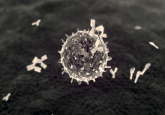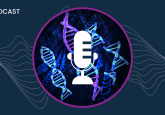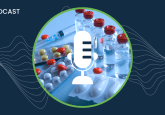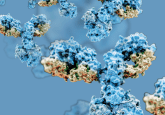ADA detection and characterization for immunogenicity testing: insights from ICON’s Lindsay Denhoff
We caught up with Principal Scientist Lindsay Denhoff (ICON) to discuss immunogenicity considerations for therapeutic proteins and the current analytical methodologies for detecting and characterizing anti-drug antibodies (ADAs). Lindsay shares some industry best practices for achieving high-quality ADA assays, as well as some of the advantages and limitations of singlicate ADA analysis compared with alternative techniques. We finish the interview with a look to the future where Lindsay discusses the emerging trends she’s spotted in the field of immunogenicity and offers her predictions for how they may shape the future of therapeutic protein development.
Podcast transcript
[00:08] Ellen Williams: Hello and welcome to this Spotlight podcast episode on immunogenicity assessment of therapeutic proteins, sponsored by ICON. I’m Ellen Williams, Digital Editor at Bioanalysis Zone and today I’m joined by Lindsay Denhoff, Principal Scientist for the Immunoassay Group at ICON. Thank you very much for joining me, Lindsay.
[00:27] Lindsay Denhoff: Thank you so much for having me, Ellen.
[00:30] Ellen Williams: You’re very welcome. So, to get us started, could you explain how immunogenicity impacts the development and efficacy of therapeutic proteins?
[00:40] Lindsay Denhoff: Absolutely. So, understanding the propensity of a therapeutic protein to generate an immune response is important for a few reasons. Dosing with a biotherapeutic can result in stimulation of an immune response to the product itself or to proteins with a related structure. The immune response has the potential to impact the efficacy of the therapeutic, as well as patient safety. And when endogenous proteins with a related structure are targeted by ADAs, that presents a significant safety risk.
And then regarding efficacy of the therapeutic, this can be impacted via reductions in bioavailability, so the amount of the drug in circulation or reduction of the ability of a therapeutic to bind to its target, which is referred to as a neutralizing antibody or a NAb. A variety of factors – such as formulation, protein modifications and structure, target, route of administration and dose – all have the potential to impact the immunogenicity of a therapeutic and should be understood and carefully considered during development. Over the years, regulations have been implemented to monitor immunogenicity. The field is still rapidly evolving and discussions on new approaches continue with the goal of monitoring effectively while also being pragmatic and efficient.
[02:01] Ellen Williams: The field of immunogenicity is very broad in terms of drug modalities and analytical techniques. So in your opinion, does this present more of a challenge or more of an opportunity?
[02:12] Lindsay Denhoff: ICON regularly encounters a variety of therapeutics of differing types that each present their own challenges when choosing an assay format, determining assessments to include in validation or determining assay tiers to include. There are also a variety of analytical approaches – so different platforms, assay formats, types of automation, techniques at the bench – to choose from to address a sponsor’s needs. The qualitative nature of immunogenicity assays also means that there are a lot of different opinions in industry related to the analysis and interpretation of data and the most ideal approach for meeting regulatory requirements.
For example, we frequently see slight variations in [the] preferred statistical analysis approach for the determination of assay cut-points among our sponsors. Experiments in criteria, generally speaking, are not as clear as for PK assays regulated by ICH M10 harmonized guidance. All these different aspects can be and often are challenging, but they also offer us the opportunity for the continued development of our own scientific knowledge and expertise, and also for collaborative engagement with our sponsors.
[03:25] Ellen Williams: So, now if we turn our focus to anti-drug antibodies specifically, what are some of the current analytical methodologies used for the detection and characterization of ADAs?
[03:36] Lindsay Denhoff: So most often we use electrochemiluminescence assays, so ECLA, and this is typically with the MSD platform. We also use enzyme-linked immunosorbent assays, also known as ELISAs, and occasionally enzyme activity assays. We also have experience using flow cytometry for readout of ADAs and mass spectrometry for IgG subclass typing of immune responses. We employ a variety of different method formats, from a simple bridging assay to more drug-tolerant formats such as affinity capture elution known as ACE, solid phase extraction with acid dissociation known as SPEAD, bead extraction and acid dissociation known as BEAD, precipitation and acid dissociation known as PandA, and high ionic strength dissociation assays (HISDA). The most appropriate format is selected based on considerations such as the therapeutic, its target and the level of drug tolerance that’s needed.
[04:40] Ellen Williams: Great. Thank you. What are some of the industry best practices for ensuring high-quality ADA detection and characterization?
[04:48] Lindsay Denhoff: So, a three-tiered approach is still industry standard for the analysis of clinical samples, so that would be a screening, a confirmatory and a titration tier. Additional tiers should be considered where domain characterization is necessary for things like multi-domain therapeutics such as bispecific antibodies or antibody-drug conjugates (ADCs) or the addition of antibody isotyping assays where there are relevant clinical concerns. Another important factor would be upfront awareness and consideration of the required assay parameters, so the assay must be able to reliably tolerate ADAs in the presence of the therapeutic – referred to as drug tolerance – its target, and/or other co-dosed medications, as well as in the presence of matrix components.
Careful selection of positive and negative controls is another important aspect. So, a good surrogate positive control is important [for] assessing and monitoring assay parameters, as is having either sufficient volume or reproducibility for long-term support of an assay. Both monoclonal and polyclonal controls are used and have their own advantages and limitations. It can be challenging to generate a positive control, especially against some therapeutics such as peptides. The negative control pool should be representative of the samples used to establish cut-points. And speaking of cut-points, the application of the appropriate statistical technique for cut-point setting is another important aspect. Establishing meaningful and appropriate cut-points is essential to obtaining meaningful assay results.
This is inclusive of appropriate and not excessive removal of outliers. Typically, data are assessed for normality followed by selection of a parametric or a nonparametric cut-point calculation, although there’s interest in industry around alternative approaches such as the application of random effects modeling. Consideration of the need for disease state population cut-points is also of importance, as is monitoring in-study false positive rate as an indication that in-study cut-points are needed. And finally, development of neutralizing antibody assays, consideration of the therapeutic’s mechanism of action and assay parameters that can be achieved should be used to determine if a cell-based or a plate-based assay is most appropriate to monitor for the neutralizing effects of ADAs.
[07:16] Ellen Williams: Great. Thank you very much. So how does ICON stay updated with the evolving industry standards and guidelines?
[07:24] Lindsay Denhoff: ICON Scientists and Managers stay informed of the current opinions in industry via attendance at conferences and meetings, participation in publications and conversations with our sponsors. We also have three bioanalytical labs globally; we have one in Lenexa, Kansas; Assen, Netherlands; and Whitesboro, New York, which is where I’m located. With roughly 500 bioanalytical staff members, we have the added benefit of having a large team of experts and the exchange of information among our sites.
[07:54] Ellen Williams: That’s lovely that you’ve got such a broad team. So what are some of the advantages and limitations then of singlicate ADA analysis in comparison to other techniques?
[08:05] Lindsay Denhoff: So singlicate ADA analysis has become a topic of interest in industry. There are a few obvious advantages to single-well analysis. The ability to analyze twice as many samples per plate translates into higher sample throughput and reduction in utilization of potentially costly reagents, materials and labor. From a regulatory perspective, there’s not an explicit requirement for duplicate-well analysis, provided an assay has very good duplicate precision, as many modern ligand binding assays do, particularly on platforms such as MSD, moving to single-well analysis should theoretically have minimal impact.
Furthermore, ADA samples typically undergo multiple analyses in the three tiers – screening, confirmatory and titer – so a switch to a single-well analysis for each tier could be expected to have minimal impact. However, due in part to the qualitative nature of immunogenicity assays, there’s still ongoing discussion in industry around how best to employ single-well analysis in terms of assay validation, and its impact on the statistical determination of parameters such as assay cut-point and 1% failure rate LPC (low positive control) setting.
For instance, should the validation be performed in duplicate wells with the results from duplicate- and single-wells compared to support the use of single-well analysis for samples? Or can the validation be performed in single wells without such a comparison? What are the impacts to variability in cut-point assessments? There’s certainly evidence in support of the use of single-well analysis for ADA. But at this point, it’s still a relatively new approach that I’m sure will become better characterized as it’s more widely used and we see that happening presently with single-well analysis for PK.
[09:54] Ellen Williams: And then finally, looking a little bit more broadly, what emerging trends do you see in the bioanalysis of immunogenicity field and how could these trends shape the future of therapeutic protein development?
[10:08] Lindsay Denhoff: As biotherapeutics evolve, so must the methods we use to assess immunogenicity. ICON has invested in examining the best analytical approach for therapeutics such as gene therapies, which are increasingly common. In addition to classic ligand binding assays, techniques such as cell-based assays with flow cytometry readout for immunogenicity assessments for cell-based therapeutics, or hybrid LBA/LC-MS assays for IgG subclass-typing to further characterize immune responses can be advantageous. As our understanding of immunogenicity continues to evolve, I think we’ll see movement in industry toward a more risk-based approach informed by upfront assessment of therapeutics and an improved understanding of the safety implications of an immunogenic response. This will allow for a more pragmatic and focused approach to assay design and validation.
[11:02] Ellen Williams: Thank you very much, Lindsay. It was lovely to be able to get your insights on this topic. Thank you very much for joining us.
[11:08] Lindsay Denhoff: Thank you so much.
About the Speaker:
 Lindsay Denhoff
Lindsay Denhoff
Principal Scientist, Immunoassay Group
ICON Bioanalytical Laboratories (NY, USA)
Lindsay Denhoff, MS, is a Principal Scientist at ICON Bioanalytical Laboratories in Whitesboro (NY, USA). Lindsay joined ICON in 2016 as a Scientist in the Immunoassay Group and although her initial focus was sample analysis, she was drawn to the challenges associated with analytical method development and the analysis of validation data. She has expertise in developing and validating pharmacokinetic, anti-drug antibody and neutralizing antibody assays across a variety of analytical platforms and method formats.
Enjoy this podcast? Explore the full Spotlight feature on immunogenicity testing for therapeutic proteins.
This feature was produced in association with:






